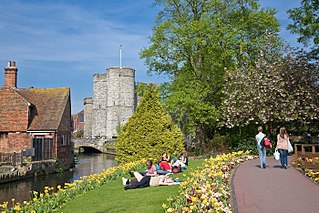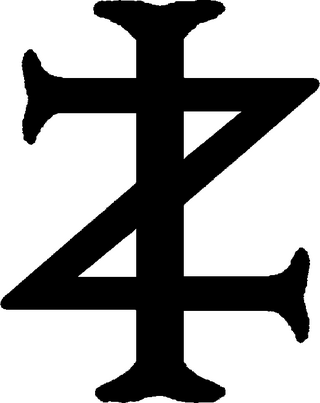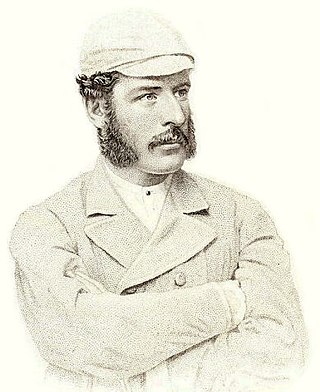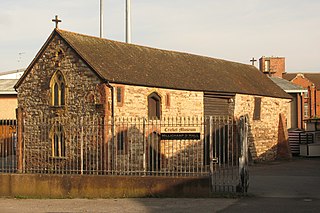Related Research Articles

Canterbury is a cathedral city and UNESCO World Heritage Site, situated in the heart of the City of Canterbury local government district of Kent, England. It lies on the River Stour.

Kent County Cricket Club is one of the eighteen first-class county clubs within the domestic cricket structure of England and Wales. It represents the historic county of Kent. A club representing the county was first founded in 1842 but Kent teams have played top-class cricket since the early 18th century, and the club has always held first-class status. The current Kent County Cricket Club was formed on 6 December 1870 following the merger of two representative teams. Kent have competed in the County Championship since the official start of the competition in 1890 and have played in every top-level domestic cricket competition in England. The club's limited overs team is called the Kent Spitfires after the Supermarine Spitfire.

The St Lawrence Ground is a cricket ground in Canterbury, Kent. It is the home ground of Kent County Cricket Club and since 2013 has been known as The Spitfire Ground, St Lawrence, due to commercial sponsorship. It is one of the oldest grounds on which first-class cricket is played, having been in use since 1847, and is the venue for Canterbury Cricket Week, the oldest cricket festival in the world. It is one of the two grounds used regularly for first-class cricket that have had a tree, the St Lawrence Lime, within the boundary.

Frederick George Brabazon Ponsonby, 6th Earl of Bessborough, was an Anglo-Irish peer who played first-class cricket 1834–56 for Surrey, Cambridge Town Club, Cambridge University (CUCC) and Marylebone Cricket Club (MCC).

I Zingari are English and Australian amateur cricket clubs, founded in 1845 and 1888 respectively. It is the oldest and perhaps the most famous of the 'wandering' cricket clubs, and is well known for its historically aristocratic membership and its colours of black, red and gold, symbolising the motto "Out of darkness, through fire, into light".

Sir Edward Chandos Leigh was a British aristocrat of the Victorian era, a barrister by profession, and a first-class cricketer. He served as President of MCC for 1887–88.
In English cricket, the years 1826–1845 were dominated by the roundarm bowling issue, which was resolved when the style was legalised in 1835, and by the formation of the first modern county clubs between 1839 and 1845.

Elton Hayes was a British actor and guitarist.

Francis Marchant, known as Frank Marchant, was an English amateur cricketer. He was a right-handed batsman, an occasional wicket-keeper and the captain of Kent County Cricket Club from 1890 to 1897.

William Yardley was an English cricketer who played first-class cricket for Kent County Cricket Club from 1868 to 1878 and for Cambridge University from 1869 to 1872. In the early 1870s, only WG Grace was reckoned his superior amongst amateur batsmen. Yardley was also an actor, playwright and drama critic.
George Marsham was an English landowner and amateur cricketer who was connected with Kent County Cricket Club.

The Old County Ground is cricket ground, located at West Malling, historically called Town Malling, in the English county of Kent. It is known to have been used for cricket matches in 1705 and has been the home ground of Town Malling Cricket Club since their formation in 1827. Known under various names throughout its existence, the ground hosted 14 first-class cricket matches between 1836 and 1890.
The Angel Ground was a sports ground at Tonbridge in the English county of Kent. It was used as a venue for first-class cricket by Kent County Cricket Club between 1869 and 1939 and then for association football by Tonbridge Angels F.C., until 1980. It was subsequently demolished and redeveloped by Tonbridge and Malling District Council in 1980.

Somerset Cricket Museum in Taunton, Somerset, England, is a small museum housing exhibits on the history of cricket with a particular emphasis on the history of Somerset County Cricket Club.

Canterbury Cricket Week is the oldest cricket festival week in England and involves a series of consecutive Kent home matches, traditionally held in the first week in August. It was founded in 1842, although a similar festival week was first held in 1839 by the Beverley Cricket Club, the predecessor of Kent County Cricket Club. Since 1847 it has taken place at the St Lawrence Ground, Canterbury, before that it was held at the Beverley Ground in the same city. In addition to hosting cricket matches, it also includes several other events and ceremonies. As of 2018, there have been 167 Canterbury Cricket Weeks held. The week continued through the Second World War with cricket being held on the ground each season.
The Beverley Ground was a cricket ground in Canterbury in Kent. It was in use in the mid-19th century, with recorded matches taking place between 1839 and 1846. It was the home ground of Beverley Cricket Club and was where the first Kent County Cricket Club was formed in August 1842 during Canterbury Cricket Week which was held at the ground until 1846.
Henry Arkwright was an English amateur first-class cricketer. He made seventeen appearances between 1858 and 1866. He is one of only three cricketers to have taken 18 first-class wickets in a match.
Lieutenant-Colonel Sir Fleetwood Isham Edwards was Keeper of the Privy Purse to Queen Victoria from 1895 to 1901.

William de Chair Baker was an English cricketer and cricket administrator who played for and was involved with Kent County Cricket Club throughout his life. Baker played first-class cricket for Kent and for Cambridge University from 1841 to 1853. He was credited as one of the originators of Canterbury Cricket Week and was secretary of Kent at the St Lawrence Ground in Canterbury from its establishment in 1847 until his death in 1888.
References
- ↑ H.S. Altham, A History of Cricket: Volume 1, 1962 edition, George Allen and Unwin Ltd, p.78.
- ↑ Shakespeare and Amateur Performance: A Cultural History - Michael Dobson, via Google Books.
- ↑ Among the Fans: From Ashes to the Arrows, a Year of Watching the Watchers - Patrick Collins via Google Books.
- 1 2 Daily Telegraph "Obituary of Sue Tilling", published 10 February 2004. Retrieved 5 June 2012.
- ↑ Canterbury Cathedral Archives & Library News, Newsletter 30, February 2005 Archived 24 March 2012 at the Wayback Machine .